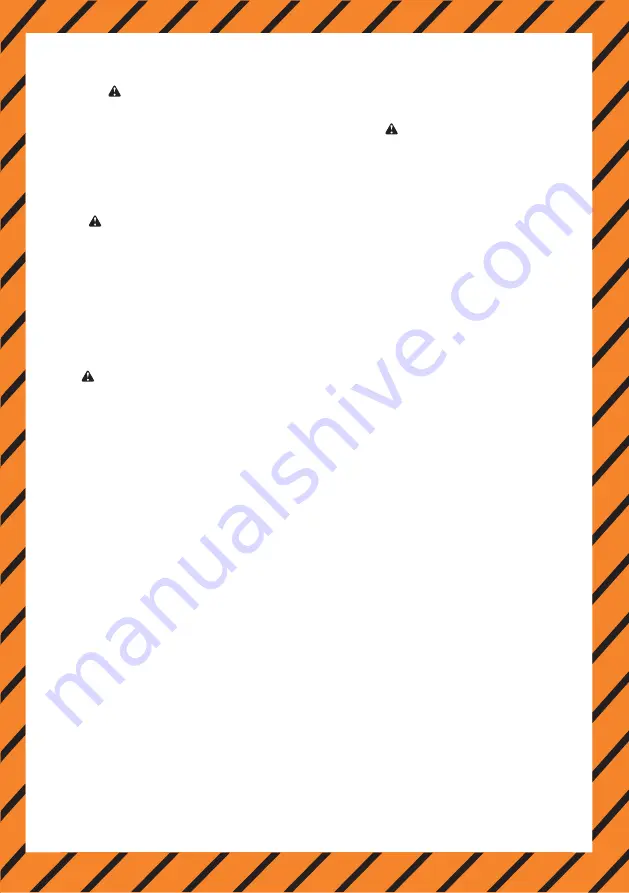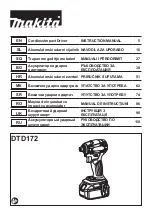
• Always use the simplest hook-up possible. Long, springy
extension bars and adapters absorb impact power and
could break. Use deep sockets wherever possible.
Operating hazards
• Operators and maintenance personnel must be physically
able to handle the bulk, weight and power of the tool.
• Hold the tool correctly: be ready to counteract normal or
sudden movements – have both hands available.
• Do not use with reduced air pressure or in a worn condi-
tion: the clutch may not operate, resulting in sudden rota-
tion of the tool handle.
• Be in control of the throttle at all times. Do not get caught
between the tool and the work.
Repetitive motion hazards
• When using a power tool to perform work-related ac-
tivities, theoperator might experience discomfort in the
hands, arms, shoulders, neck, or other parts of the body.
• Adopt a comfortable posture whilst maintaining secure
footing and avoiding awkward or offbalance postures.
Changing posture during extended tasks can help avoid
discomfort and fatigue.
• Do not ignore symptoms such as persistent or recurring
discomfort, pain, throbbing, aching, tingling, numbness,
burning sensation,or stiffness. Stop using the tool, tell your
employer and consult a physician.
Noise and Vibration hazards
• High sound levels can cause permanent hearing loss and
other problems such as tinnitus. Use hearing protection
as recommended byyour employer or occupational health
and safety regulations.
• Exposure to vibration can cause disabling damage to the
nerves and blood supply of the hands and arms. Wear
warm clothing and keep your hands warm and dry. If
numbness, tingling, pain or whitening of the skin occurs,
stop using tool, tell your employer and consult a physician.
• Hold the tool in a light but safe grip because the risk from
vibration is generally greater when the grip force is higher.
Where possible use a suspension arm or fit a side handle.
• To prevent unnecessary increases in noise and vibration
levels:
• Operate and maintain the tool, and select, maintain and
replacethe accessories and consumables, in accord-
ance with this instruction manual;
• Do not use worn or ill-fitting screwdriver bits, sockets or
extensions.
• Do not touch sockets or accessories during impacting.
Workplace Hazards
• Slip/Trip/Fall is a major cause of serious injury or death.
Be aware of excess hose left on the walking or work sur-
face.
• Avoid inhaling dust or fumes or handling debris from the
work process which can be harmful to your health (for
example, cancer, birth defects, asthma and/or dermatitis).
Use dust extraction andwear respiratory protective equip-
ment when working with materials which produce airborne
particles.
• Some dust created by power sanding, sawing, grinding,
drilling and other construction activities contains chemicals
known to the State of California to cause cancer and birth
defects or other reproductive harm. Some examples of
these chemicals are:
• Lead from lead based paints
• Crystalline silica bricks and cement and other masonry
products
• Arsenic and chromium from chemically-treated rub-
ber Your risk from these exposures varies, depending
on how often you do this type of work. To reduce your
exposure to these chemicals: work in a well ventilated
area, and work with approved safety equipment, such
as dust masks that are specially designed to filter out
microscopic particles.
•
`
Proceed with care in unfamiliar surroundings. Be aware of
potential hazards created by your work activity. This tool is
not insulated from coming into contact with electric power
sources.
•
`
This tool is not recommended for use in potentially explo-
sive atmospheres.
Summary of Contents for CP7739 Series
Page 8: ...www cp com ...


























